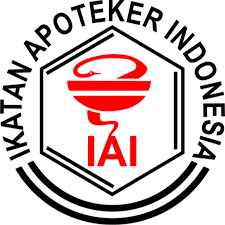Formulasi dan Karakterisasi Sediaan Nanoemulgel Serbuk Lidah Buaya (Aloe Vera L.)
Teguh Imanto(1*), Roseh Prasetiawan(2), Erindyah Retno Wikantyasning(3)(1) Universitas Muhammadiyah Surakarta
(2) Universitas Muhammadiyah Surakarta
(3) Universitas Muhammadiyah Surakarta
(*) Corresponding Author
Abstract
Aloe vera L. contains antiseptic saponins and anthraquinone complexes as antibacterial. This research was conducted to formulate aloe vera powder into nanoemulgel, characterize and test its physical properties, and to know the effect of gelling agent concentration (carbopol and chitosan) on nanoemulgel. Emulsion type used is oil in water (O / W) with surfactant tween 80 and co-surfactant propylene glycol. Nanoemulsion is characterized by percent of transmittance with UV-Vis spectrophotometer, also potential droplet and zeta size distribution with Particle Size Analyzer. Hydrogels consist of 4 combination formulas of carbopol 0.5%; 1%; 1.5%; 2% and 0.3% chitosan. The formula is tested for physical properties including organoleptic, pH, spreadability, adhesion, viscosity and stability with freeze thaw method. The results showed that the nanoemulsion droplet size was 65.05nm ± 13.49 with zeta potential of -0.1mV and the percent of transmittance above 98%. The result of physical properties of the four formulas shows that the different gelling agent concentration gives different physical properties of viscosity and spreadability. Overall, formula 3 has the best physical properties and physical stability compared to formula 1, 2 and 4.
Keywords
Full Text:
PDFReferences
Ahlam, 2011, Formulasi Sediaan Gel Ekstrak Lidah Buaya (Aloe vera L.) dengan Gelling Agent Kitosan dan Uji Efek Penyembuhan Luka Bakar, Naskah Publikasi, Universitas Muhammadiyah Surakarta.
Al-Fatimi M., Wurster M., Schröder G. and Lindequist U., 2007, Antioxidant, antimicrobial and cytotoxic activities of selected medicinal plants from Yemen, Journal of Ethnopharmacology, 111 (3), 657–666.
Arellano A., Santoyo S., Martín C. and Ygartua P., 1999, Influence of propylene glycol and isopropyl myristate on the in vitro percutaneous penetration of diclofenac sodium from carbopol gels, European Journal of Pharmaceutical Sciences, 129–135.
Azizah R.T., 2018, Uji Aktivitas Antibakteri Gel Serbuk Lidah Buaya (Aloe vera var.sinensis) Berbasis Carbopol 934 Terhadap Staphylococus aureus dan Pesudomonas aeruginosa, Naskah Publikasi, Universitas Muhammadiyah Surakarta.
Bashir A., Saeed B., Mujahid T.Y. and Jehan N., 2011, Comparative study of antimicrobial activities of Aloe vera extracts and antibiotics against isolates from skin infections, African Journal of Biotechnology, 10 (19), 3835–3840.
Christiawan A. and Perdanakusuma D., 2010, Aktivitas Antimikroba Daun Binahong Terhadap Pseudomonas aeruginosa dan Staphylococcus aureus yang sering menjadi Penyulit Pada Penyembuhan Luka Bakar, Jurnal Ilmu Bedah plastik, 1–6.
Elya B., Dewi R. and Budiman M.H., 2013, Antioxidant cream of Solanum lycopersicum L., International Journal of PharmTech Research, 5 (1), 233–238.
Furnawanthi I., 2002, Khasiat dan Manfaat Lidah Buaya, Agro Media Pustaka, Jakarta.
Garg A., Aggarwal D., Garg S. and Singla A.K., 2002, Spreading of semisolid formulations An Update, Pharmaceutical technology, www.pharmtech.com, 84–105.
Hapsari I., Rosyadi A. and Wahyuningrum R., 2014, Optimasi Kombinasi Minyak Atsiri Bunga Kenanga Dengan Herba Kemangi Dalam Gel Sebagai Repelan Nyamuk Aedes aegypti Dengan Metode Simplex Lattice Design, Prosiding Seminar Nasional dan Workshop “Perkembangan Terkini Sains Farmasi dan Klinik IV” tahun 2014, 31–37.
Kumar M.N.V.R., Muzzarelli R.A.A., Muzzarelli C., Sashiwa H. and Domb A.J., 2004, Chitosan chemistry and pharmaceutical perspectives, American Chemical Society, 104 (12), 6017–6084.
Mason T.G., Wilking J.N., Meleson K., Chang C.B. and Graves S.M., 2006, Nanoemulsions: Formation, structure, and physical properties, Journal of Physics Condensed Matter, 18 (41), 635–666.
Mou D., Chen H., Du D., Mao C., Wan J., Xu H. and Yang X., 2008, Hydrogel-thickened nanoemulsion system for topical delivery of lipophilic drugs, International Journal of Pharmaceutics, 353 (1–2), 270–276.
Prabaharan M. and Mano J.F., 2005, Chitosan-based particles as controlled drug delivery systems, Drug Delivery: Journal of Delivery and Targeting of Therapeutic Agents, 12 (1), 41–57.
Ramadhan F.A., 2016, Formulasi Sediaan Gel Nanoemulsi Ekstrak Kulit Buah Rambutan (Nephelium lappaceum L): Stabilitas Fisik dan Aktivitas Tabir Surya, Naskah Skripsi, Universitas Muhammadiyah Surakarta.
Sativa O., Yuliet and Sulastri E., 2014, Uji Aktivitas Antiinflamasi Gel Ekstrak Buah Kaktus (Opuntia elatior Mill.) Pada Tikus (Rattus norvegicus L.) Yang Diinduksi Lamda Karagenan, Online Journal of Natural Science, 3 (2), 79–94.
Singh B.P., Kumar B., Jain S.K. and Shafaat K., 2012, Development and characterization of a nanoemulsion gel formulation for transdermal delivery of carvedilol, International Journal of Drug Development and Research, 4 (1), 151–161.
Tranggono R.I. and Latifah F., 2007, Buku Pegangan Ilmu Pengetahuan Kosmetik, Djajadisastra, J., ed., PT. Gramedia, Jakarta.
Wahyuningsih I. and Putranti W., 2015, Optimasi Perbandingan Tween 80 dan Polietilenglikol 400 pada Formula Self Nanoemulsifying Drug Delivery System (SNEDDS) Minyak Biji Jinten Hitam, Pharmacy, 12 (02), 223–241.
Wang J.J., Sung K.C., Hu O.Y.P., Yeh C.H. and Fang J.Y., 2006, Submicron lipid emulsion as a drug delivery system for nalbuphine and its prodrugs, Journal of Controlled Release Elsevier, 115 (2), 140–149.
Widayanti A., Fauziah D.A. and R N.S., 2016, Formulasi Sediaan Gel Kolagen Ikan Tuna (Thunnus albacares) Dengan Hidroksipropil Metilselulosa (HPMC) Sebagai Gelling Agent, Farmasi sains, Universitas Muhammadiyah Prof. DR. Hamka, 3 (1), 1–6.
Article Metrics
Abstract view(s): 4651 time(s)PDF: 9670 time(s)
Refbacks
- There are currently no refbacks.








